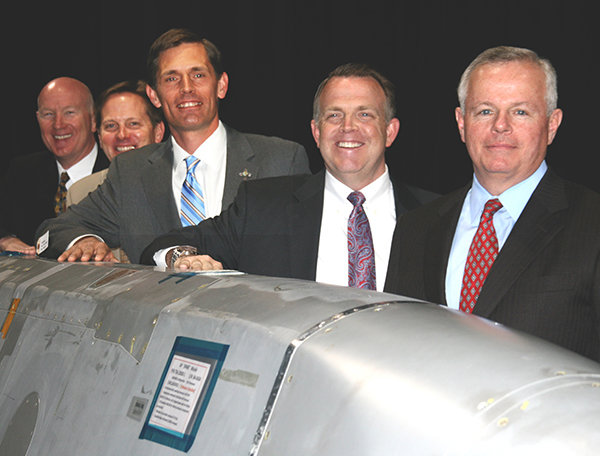
At an event where he announced a $10 million effort to further develop directed-energy technology for the nation’s military, Sen. Martin Heinrich, third from right, is joined by, from left, Center 5400 Director David Plummer; Kelly Hammett, chief engineer, Directed Energy Directorate, Air Force Research Laboratory; Heinrich; Robert Fitzpatrick, VP for Business Development, Raytheon Missile Systems; and Steven Downie, site director, Raytheon Albuquerque. (Photo by Linda von Boetticher)
A team developing a missile that uses high-powered microwaves (HPM) to knock out enemy electronics received $10 million from the Air Force to prepare the weapon for the battlefield.
Sandia has worked on the HPM technology that enabled the Counter-Electronics High-Power Microwave Advanced Missile Project, or CHAMP, for more than two decades, says Jeff Alexander, manager of Directed Energy Special Applications Dept. 5443.
“HPM provides a game-changing, scalable, and non-lethal option for the warfighter,” Jeff says. “The technology will save lives by more closely targeting and crippling an enemy’s electronics systems without hurting civilians or even the building containing the targeted electronics.”
Sen. Martin Heinrich, D-N.M., announced the $10 million effort that includes a $4.8 million contract for Raytheon Ktech in the Sandia Science & Technology Park; $3.8 million for the Air Force Research Laboratory (AFRL); and $1.4 million that Sandia received from the Air Force to refurbish and enhance the CHAMP payload. The work is being done under an existing strategic partnership with AFRL.
“This contract will allow Raytheon Ketch here in Albuquerque, as well as Sandia and AFRL, to take this to the next level,” Heinrich said. “I truly believe that directed-energy weapons will play a critical role in future weapons systems across the military. Directed-energy technology will provide the military with a qualitative advantage over our adversaries.”
The refurbishment and enhancement effort is the next step for CHAMP technologies, following a 2012 flight test.
Directed-energy weapons emit highly focused energy — examples are HPM and lasers — to destroy a target.
For CHAMP, the Labs has provided pulsed-power engineering, high energy density physics design and modeling, and weaponization of the technology’s hardware and components, said David Plummer, director of Integrated Military Systems Center 5400.
“AFRL and Sandia have worked together for more than 20 years. We think our partnership is a model for interagency collaboration, in this case between Defense and Energy,” David said.
If the partners are successful in fielding CHAMP, the work could set the stage to develop a substantial funding stream for directed-energy work in New Mexico, Heinrich said.
In addition to working with national firms, Sandia’s directed-energy work also has benefited laboratories and businesses in the state, David said. “New Mexico is poised to play a significant role in the future of this technology,” he said.
Champ team members: The 2013 ERA Team for CHAMP’s currently active employees include: Fernando Bitsie and Eric Stasiunas (both 1521); Burke Lloyd Kernen, Enrico Quintana, and Kyle Thompson (all 1529); Joshua Usher (1647); Guillermo Loubriel (1755, formerly 5443); Grace Santillanes (2633); David Joseph Gurule (2557); Jason Shelton (2728); Steven Dron (5426); Jeff Alexander, Phillip D. Coleman, Paul Primm, and Jeffery T. Williams (all 5443); and Larry Lucero (5445).